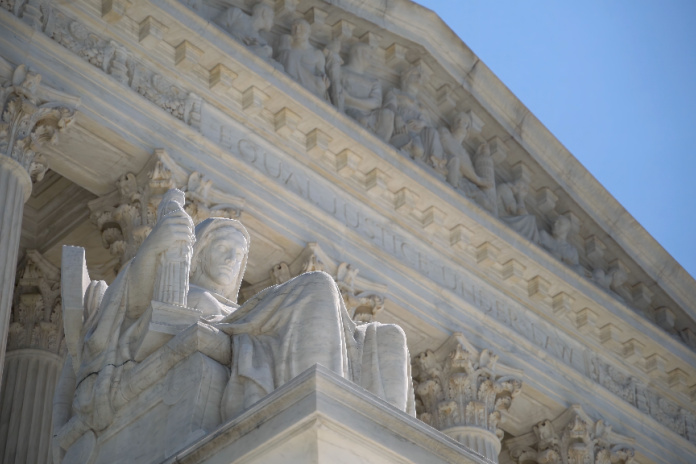Recent media stories have invited intense scrutiny of the United States Supreme Court. As the nine justices collectively handed down arguably controversial decisions this last month, they leave some people wondering what role they and the Supreme Court play in the American federal government. When you count yourself among those asking such questions, you can better understand why the court exists as the third government branch by learning more about the justices and their judicial purpose.
An Overview of the U.S. Supreme Court Justices
The U.S. Supreme Court, or SCOTUS as many Americans call it, consists of nine justices. They receive the name “justice” upon their appointment. The term “justice” denotes their high judicial station, as well as the authority they possess in determining cases and potentially creating new federal laws.
The President of the United States nominates federal judges of his or her choosing to sit on the Supreme Court whenever a judicial vacancy exists. Many presidents select judges who subscribe to the same political beliefs or belong to the same political party. However, upon taking the oath of office, SCOTUS judges affirm to uphold and defend the Constitution of the United States.
The nominated justices must first sit for a Senate review before their appointment. The U.S. Senate has the obligation of vetting SCOTUS nominees to weigh their fitness to sit on the highest court in the land. The vetting process can take several days, if not a week or longer, before the Senate either approves or denies the nominee’s appointment.
Upon approval from the Senate, the new SCOTUS justice is sworn into office and immediately begins his or her new role in deciding cases and issuing judgments. The decisions from the nine justices collectively often change or create new federal laws and establish cases by which future legal matters at all levels are decided.
The Court of Last Resort
Many legal experts regard SCOTUS as the “court of last resort” because it hears dozens of appellate cases every year. These cases have made their way up from municipal or county courts, through state and federal appeals courts, all the way to the U.S. Supreme Court.
The SCOTUS justices can either agree with the decision of the federal appeals court or send the case back to a lower court for reconsideration. They can also overturn the ruling of a federal court and decide in the opposing party’s favor, which can then result in the creation of a new federal law. This decision also becomes a benchmark against which legal cases throughout the U.S. must abide.
People who are not content with a lower court’s ruling have the option of petitioning their cases all the way to the Supreme Court. It may take several years for a case to reach this highest level, the court of last resort, and take months or longer to get the justices to decide it when they finally receive the case for consideration.
Judicial Review
The legal case Marbury vs Madison in 1803 established the U.S. Supreme Court as the final judicial review for legislative and executive acts. That is, SCOTUS has the legal right and obligation to determine if a congressional law or a presidential order abides by the U.S. Constitution and established case law.
This role of the court often invites controversy, depending on which way the justices rule, because one political party may argue the court favors the other political party more. The political alignment of the justices can create contention among politicians and voters. People may say the justices only decided how they did because of their favor for the president, Congress or a particular political party.
However, the decisions of the justices must conform to the U.S. Constitution that they are sworn to uphold, protect and defend. They likewise can create new federal laws or establish case law through their judicial review of legislative and executive actions.
Jurisdiction
SCOTUS additionally has jurisdiction over cases regarding disputes between or among states. For example, if one state sues another, that state can take its case to the Supreme Court and have SCOTUS issue the final decision about the case’s validity and outcome. In many circumstances, cases involving litigation between or among states must rely on the jurisdiction of the Supreme Court to eliminate the possibility of state or appellate court bias.
Additionally, SCOTUS retains jurisdiction over cases involving constitutional or federal law. The justices have the legal capability to either overturn or reform a law. They can also decide to uphold the law as it is written. Their decisions must abide by the U.S. Constitution and cannot create new laws that violate the Constitution or its amendments.
Guardians of the U.S. Constitution
Finally, the U.S. Supreme Court exists as the primary guardian of the U.S. Constitution. The nine justices take oaths to protect, defend and uphold the Constitution as it is written. They do not have the legal authority to render decisions outside of the confines of the Constitution or make up new laws randomly.
They also serve to check and balance the other two branches of government. For example, if the president tries to become a dictator and not leave office at the end of his or her term, the Court can hear and decide any legal action that Congress, a state or an individual petitioner files against the president.
Likewise, if Congress creates laws that do not abide by the Constitution, the Court can determine those laws’ legality and overturn them. SCOTUS works in conjunction with the other two branches, as well as independently, to maintain an equal balance and function within the confines of the federal government.
The United States Supreme Court is a vital branch of the U.S. federal government. The nine justices, whom the president nominates and the Senate approves, can create new laws and overturn existing ones. They also work collectively to maintain the federal government’s checks and balances system.
